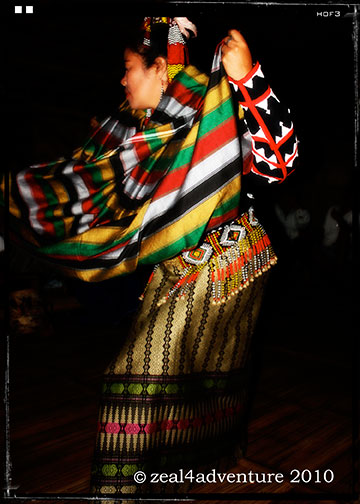This is my last post on the T’bolis and it’s beautiful land, Lake Sebu and what better way to honor its people and its land than to celebrate its cultural heritage through vivacious singing and dancing. No, we didn’t dance nor sang BUT…
On our last night in Lake Sebu, our host prepared a simple musical production in honor of their heritage. The T’bolis are masters at music, dance and storytelling.
After dinner, young T’boli women, men and children garbed in their traditional and colorful costumes gathered on one side of the longhouse getting ready to perform while eight friends in shorts and t-shirts looking forward to the show. It started with our host introducing their culture, particularly their type of dance and music. Inspired by nature, they imitate in their music the sounds of birds chirping, water flowing and the blowing of the wind.
These indigenous people have a rich musical heritage and a wide array of musical instruments.
This is a Hegulong (t’boli guitar) that was played by the bead maker we saw earlier that day. It is said that a hegulong can only be made from a specific tree and a densu (ritual) of offering something to Tulus funen (a spirit who dwells among trees) must be accomplished before the instrument can be blessed with good tunes.
These performances are not for entertainment but it is more of their way of seeking wisdom from their ancestors.
Their dances likewise are mimics from the actions of animals, such as monkeys and birds.
This boy was the star of the night. He twirled, tumbled, scratched and did all things a normal monkey does.
It was cute and hilarious. The T’boli children—whenever they gather – tap anything in sight in rhythmic beats.
Something perhaps like what these kids were doing.
But as in many cultural heritages, the T’boli’s are threatened. The community owned School of Indigenous Knowledge and Training (SIKAT) was set up to address their vanishing culture.
SIKAT is a school that revitalizes cultures and traditions in their indigenous education program, which includes traditional music and dances. It is their aim to encourage students to learn in their own language and to value their heritage.
Getting There:
General Santos City is the gateway to Lake Sebu. From the bus terminal take a bus to Koronadal (often referred to as Marbel, its old name) and get off at the Koronadal bus station. Tell the conductor to drop you off there. The trip is about 45 minutes. From Koronadal, take the Yellow Bus to the town of Surralah (about 38 minutes). From Surralah, take a jeep to Lake Sebu (about 43 minutes).
On the other hand, one can also arrange for pick-up, depending on the resort you stay at.












Great photos of an amazing event. I’ve never visited that part of the world but would love to do so.
LikeLike
What a fascinating people. I sure hope that their traditions and culture would be preserved even if its people start going away from home.
Excellent coverage, text and photos.
LikeLike
Very interesting post.
LikeLike
aloha,
thanks for showing us your world today, i like all the beautiful costumes, i’m sure the dancing and singing and music must have been very mesmerizing!
i enjoyed the show and tour
LikeLike
Wonderful tradition. The traditional outfits of the people are beautiful.
LikeLike
Enjoyed reading about their traditions and culture. Great shots.
LikeLike
A beautiful post of a beautiful culture. Like many indigenous cultures around the world, there is a great struggle to hold on to that which makes them unique. I hope they are successful.
LikeLike
interesting post, thanks for sharing. 🙂
LikeLike